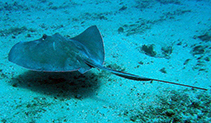| Family: |
Dasyatidae (Stingrays), subfamily: Dasyatinae |
| Max. size: |
68 cm WD (male/unsexed); 61.8 cm WD (female) |
| Environment: |
demersal; marine |
| Distribution: |
Atlantic: Brazil. |
| Diagnosis: |
This species is distinguished from non-Hypanus species that occur in the western Atlantic by the presence of dorsal a caudal ridge (vs. absence in Bathytoshia centroura, a dorsal caudal fold in Dasyatis hypostigma); absence of a w-shaped notch in the central ventral disc (vs. presence in D. hypostigma); and with the anterior portion of the disc with angle varying from 125°-135° and a clear ventral disc (vs. 150° and dark ventral disc in Pteroplatytrygon violacea). It differs from most Hypanus species, except those from the H. americanus species group, it can be distinguished by the diamond-shaped body with a short snout (vs. long snout in H. guttatus, H. sabinus); presence of ventral caudal fold and dorsal caudal ridge (vs. ventral and dorsal caudal folds in H. marianae, H. dipterurus, H. say, H. sabinus); a white spot between the eyes anterior to the precerebral fontanelle (vs. absent in H. marianae, H. guttatus, H. dipterurus, H. say, H. sabinus); differs from the species of the H. americanus clade (H. americanus, H. longus, H. rudis) by the presence of sparse black spots on the dorsal disc of live specimens (vs. absent) and by 11 morphometric measurements, the most relevant being spiracle length or SPL [18.62% (16.21%-22.47%) of head length or HDL vs. 19.61% (15.85%-32.81%) in H. americanus, 18.37% (17.03%-21.89%) in H. longus and 24.79% (23.55%-26.11%) in H. rudis] and ventral caudal fold height or VFH [1.92% (1.37%-2.3%) of DW vs. 1.74% (0.83%-2.83%) in H. americanus, 1.39% (0.75%-2.71%) in H. longus and 1.55% (1.1%-1.81%) in H. rudis]. In male adults of H. berthalutzae and H. americanus, the pelvic fin length or P2L is smaller than the distance from apopyle to clasper tip (ap-tip), whereas it is larger in H. longus. The measurement P2L/ap-tip is 54.16% in H. berthalutzae [vs. 49.43% (41.78%-56.33%) in H. americanus and 119.44% (113.20%-124.15%) in H. longus] (Ref. 123757). |
| Biology: |
Mostly a coastal species, usually at the continental shelf, and reported to occur in localities up to 250 km off the coast (Ref. 123757). |
| IUCN Red List Status: |
Vulnerable (VU); Date assessed: 08 August 2020 (A2d) Ref. (130435)
|
| Threat to humans: |
harmless |
| Country info: |
|
Source and more info: www.fishbase.org. For personal, classroom, and other internal use only. Not for publication.

